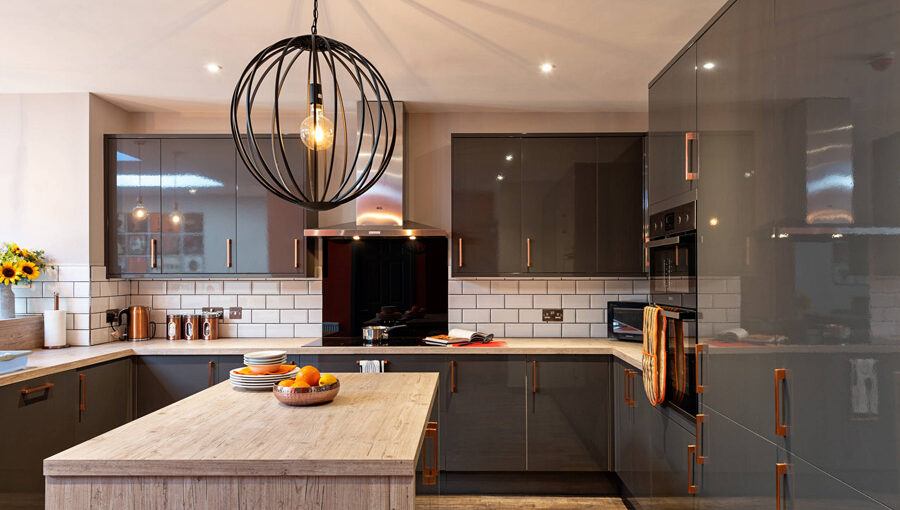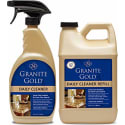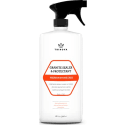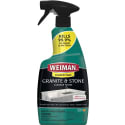Falling in love with your kitchen countertops begins at first sight – which is why visiting a showroom is so important. However, you will make the most out of your trip if you become familiar with some basic concepts and how countertops fit in your overall design. After all, kitchen remodel is an integrated process, considering the countertop material and color selection along with the kitchen cabinets, paint for the walls, backsplash material, and appliances.
It’s normal to feel nervous at this point in the design process. After all, you’ve been waiting for the time where you could finally have your dream kitchen. You’ll want to make sure your choice doesn’t negatively affect things such as your home’s resale value or your long-term enjoyment.
Thankfully, there is good news. You can budget ahead, and many product options cover all price points. We’re here to walk you through everything involved in this step of your remodel plan so that you can feel confident and knowledgeable when shopping for the perfect kitchen countertops.
How to Choose the Best Kitchen Countertops?
The Aesthetics – Overall Visual of Your Countertop
Each surface is unique, and when you’re dealing with stone like granite vs quartz, then you may find that appearance can vary even between different cuts of the slab. The characteristics that make each countertop unique are more than skin deep, though. Feeling each countertop can also introduce a new aspect – after all, while it may be surprising, each material feels totally different.
While you want a countertop that’s fully functionally and works best for your needs, you also want one that you enjoy looking at. After all, whether you’re cooking, hosting, or just doing homework on the island, your countertops will be one of the most visually noticeable aspects of your kitchen.
As a result, you’ll want to make sure that when you’re shopping for the best countertops for you that you consider which surface is the most appealing to you. This involves taking aspects like the overall look and feel as well as the color and texture into consideration while shopping.
Here are some of the most important things to think about:
- Whether you want a surface that is warm or cool to the touch
- Rich colors, shades, and elegant veins
- Overall fit and finish in comparison to other design elements such as the backsplash, paint colors, cabinet colors, hardware (pulls and knobs) finishes
You’ll also want to think about additional details, such as the thickness, edge, and overhang. While more minor details than noticeable aspects such as the color, these extra details can help change your kitchen’s entire appearance. We will examine these in detail below.
Take the waterfall design style, for example. This is a popular style in high-end kitchens that helps add a luxurious feel. It involves encasing your island so that the counter extends across the top and over both sides to reach the ground, leaving the front cabinets exposed.




Different countertop materials will provide other aesthetic options. Synthetic options like laminate and solid surfaces and natural options like wood and granite can vary significantly in appearance. Taking the time to research each option down to the smallest details and consider how it will look with your cabinets, walls, and even your backsplash will help make sure you love your kitchen’s end result.
What is the Best Material? Quartz, Granite, Butcher Block & More
You have a variety of options when it comes to choosing the right type of material for your kitchen countertops.
- Granite
- Quartz (usually referred to by brand names such as Silestone, Ceasarstone, Cosentino)
- Marble
- Butcher block
- Solid Surface (usually referred to by brand names such as Formica or Corian)
- Laminate
- Concrete
In addition, you can also mix and match some of these materials in large kitchen installations depending on the look you are creating. This allows you to reap the benefits of many materials, helping to create a fully functional kitchen.
Most mid to high-end kitchens use granite or quartz.

Granite Countertops
Granite is one of the most popular options for kitchen countertops, with a particular favor towards high-end kitchens. Granite is a natural stone loved for its unique color, shades, and veins. With its natural beauty, it makes a great addition to any kitchen.
Granite is also one of the most durable materials for countertops. As a result, whether you cook often, have young children, or like to host, you’ll find it’s able to hold up to most daily wear and tear – all while maintaining a luxurious finish.
Price $$ – $$$
| Pros | Cons |
|---|---|
| Luxurious look | You need to seal it once a year to protect against stains |
| Extremely resistant to heat | Carefully select your cleaning materials |
| Scratch-resistant | |
| Stain-resistant | |
| Durable under sun light | |
| Non-porous – it is sanitary |
Quartz Countertops
Quartz countertops are also a favorite. Quartz is an engineered material commonly made under names such as Silestone, Ceasarstone, and Cosentino. It’s high-end and luxurious, with high-quality durability that makes it great for even the most functional kitchen. It’s easy to maintain and holds up well to wear and tear.
It’s also extremely diverse. You’ll have a variety of colors to choose from, helping create an upscale look by choosing the perfect shade for your kitchen countertops. This helps you maintain an area that isn’t just unique but is seamless in aesthetic for a kitchen you’ll want to show off every chance you get.
Price – $$$ Most expensive material
| Pros | Cons |
|---|---|
| Luxurious look | Some brands are susceptible to discoloration under UV light |
| Easy to coordinate colors | Excessive heat is a problem (unlikely in most residential kitchens) |
| No maintenance (just soap and water to clean) | Do not use harsh chemicals |
| Nonporous – no need to seal | |
| Heat resistant | |
| Stain-resistant | |
| Does not scratch |
Butcher Block Countertops
A trendy option right now is the butcher block countertop style. Especially when mixed with either granite or quartz countertops, butcher block offers rich, natural color variety to your kitchen. Significantly thicker style of this material lends well to a chef inspired look.
Most often, you’ll find that butcher block countertops act as an accent, composing a small area usually near your sink or on the island. However, it’s important to remember that wood can scratch easily – just think about your cutting board. You’ll also need to clean them often by scrubbing away grime with a sponge and hot water and sanitizing them with undiluted white vinegar.

Marble Countertops
Most medium to high-end kitchens come with granite or quartz countertops. However, if you are considering a “dramatic” look you may want to explore the true three dimensional presentation of marble with deep veins.
Marble is a softer stone compared to granite. However, if you are considering a white countertop finish, marble might have an edge over other options.
Price $$ – $$$
| Pros | Cons |
|---|---|
| Luxurious and unforgetable look | You need to seal it once or twice a year to protect against stains |
| Resistant to heat | Prolonged exposure to acids (like lemon juice) might erode the polish and sealant |
| Easier to cut compared to granite or quartz | Be careful with red wine stains |
Solid Surface
Solid surface is an affordable option engineered from acrylic. Most people use the brand names such as Formica or Corian interchangeably to refer to this material.
Besides the low-pricepoint, solid surface countertops have many color and pattern options. They are also easy to install and repair. However, make sure to keep your hot pots and pans on a trivet as they will indent the solid surface. In addition, Formica or Corian are not scratch resistant.
Laminate
Laminate is the budget-friendly option that consists of layers of plastic layered over hardwood.
Price $
Pros
- Durable
- Easy to clean with soap water
- Many colors and patterns
- Easy to install, cut & modify
Cons
- Heat
- Scratch
- The overall look is not high-end
Concrete Countertops
Concrete countertops are another budget-friendly option. They’re extremely durable, and you can add a coat of decorative resin to help match your countertops to your kitchen’s style. Even plain concrete is stylish and trendy, however. They can help create an industrial look.
Function – Food Preparation, Spills & Schoolwork
When deciding which countertop material is right for you, it’s important to think about how you plan to use your kitchen. Are you a passionate home chef who loves to spend your evenings cooking and experimenting to find your next favorite dish? Do you like to use your kitchen as a gathering area when you host? Do you have children that make the most adorable messes each morning?
All of these are important things to consider, as each will affect the durability and support you need from your countertop. For example, if you spend most of your kitchen time cooking, you’ll want to make sure you have durable countertops that are resistant to scratches and water damage. Yet, a butcher block countertop close to your sink might save you time when cutting and chopping. If you have young children, you may want to stay away from white marble countertops because spills can damage them.
As a result, it’s important to rank each material in terms of durability, resistance, and ease of maintenance.
Decorative Edges
One of the best parts of your kitchen renovation project is the fact you get to customize even the smallest details to help turn your dream kitchen into a reality. One of these details is the edge of your countertop.
The edges of your countertop are like the face frame of your cabinet: they’re a small detail that you can customize in order to change the entire tone of your kitchen. The decorative edge you choose can help reinforce the look and style you’ve chosen for your kitchen, whether that’s traditional, transitional, or modern.

Different decorative edges can also change the levels of safety in your kitchen – especially if you have children. You’ll find that rounded edges such as the waterfall or the ogee pose less of a safety hazard for children than 90-degree edges because they’re not as sharp on the corners.
You’ll also want to consider the future (as well as the past). Nothing is permanent in interior design, and edges are no exception. In fact, the prevalent design on edges changes every 5 to 8 years, so you’ll want to make sure to ask the pros when you’re trying to stay ahead on trends. Consider the trends of the past and think about the overall aesthetic of your home – this detail will help you form the best opinion when choosing the perfect edge.
Pro Tip! The usual depth of countertops is 26-inches including the overhang. A counter depth refrigerator has a 24-inches deep main box.
Thickness
You’ll also want to take thickness into account when designing your kitchen countertops.
The standard countertop thickness in the US is typically 1 ¼ inch (i.e., 3 cm). However, this can vary based on design. For example, porcelain is about ¼ inches thick, while countertops with a waterfall edge design will require a thickness of 2 to 2.5 inches.
But why is thickness important?
When you’re working with heavy stone countertops such as granite or quartz, you want to make sure the stone will be able to support itself. Crossing a large span such as a long kitchen island, working around imperfect base cabinets require expertise. Choosing a reputable stone supplier is the best way to prevent any potential mishaps.
Recently, thicker countertops have come into popularity, especially in minimalist, modern kitchens where their texture and style stand out. Thicker slabs usually have more choices in terms of darker colors, especially in natural stone. They’re also a more high-end choice, helping add value to your kitchen and thus your overall home.
Seams & Seamless Appearance
You want your kitchen countertop to be smooth and seamless, especially when you’re dealing with stone. Each piece of stone used in your countertop should be as big as possible to avoid any unnecessary seams as well as to help hide the seams that must exist – after all, you don’t want a patchwork of stone on your counters.
If you’re looking for a professional to help with your countertops, looking at the way they handle their seams can be a great way to judge the quality of their craftsmanship. It’s important to look for a professional who understands the importance of seamless, smooth countertops and can work to help you achieve this.

Perfecting the seam will also affect how your sink and appliances fit in. You want to make sure that all of your appliances, sinks, and faucets sit on an area of smooth, uninterrupted stone. This can involve some major planning in advance because you want to make sure it’s perfect the first. Otherwise, you may end up with some cosmetic flaws that you don’t quite love: such as a seam running right through the middle of your sink opening.




Sinks – Farmhouse, drop-in, undermount
When designing for your countertops think of your sink selection. Do you like the look of a farmhouse sink with an apron that is visible? Or you would prefer a smooth, hidden look of an undermount sink?

Alternatively, you may want to reveal the thick edges of your sink over the countertop. In that case, a drop-in sink might be your best choice.

Range vs Cooktop
Ranges are a popular choice in modern kitchens. You will get a cooktop and a stove all in one appliance. However, the range causes a break in the countertop lines.
If the seamless look is the ultimate design goal you may want to consider a cooktop. As an example, the smooth glasstop induction cooktop not only blends well with your countertop but also allows for an easy clean.

How To Clean Countertops – Maintenance
Everything you own experiences wear and tear, and your kitchen countertops are no exception. As a result, at some point in time, you’ll need to take steps to maintain your countertops. How often this point in time occurs, though, depends on the type of material you choose for your kitchen countertops.
While all kitchen countertops require maintenance such as regular cleaning, some, such as natural stones, require more – especially porous materials like granite countertops. Also, you should act quick to remove stains from your countertops before the marks become permanent.
When you invest in granite countertops, you’ll get to experience high-quality durability and resistance to damage. However, since granite is porous, it won’t be able to do this on its own. In fact, without a proper sealant applied regularly, you’ll notice that you’ll need to replace your granite countertops in no time.
You may be familiar with the process of sealing already. It’s when you apply a chemical seal that acts as a coating for your material of choice, helping to keep damage from reaching the raw material. Since granite countertops are porous, the seal will seep into the pores and fill them, preventing liquids or stains from damaging the raw stone.
Unlike granite countertops, quartz countertops don’t need to be sealed. Quartz is naturally durable, and since it is non-porous, you’ll find that it doesn’t even take to the sealant. In fact, more often than not, you’ll notice that if you do try to seal your quartz countertop that the sealant is left behind as a film of liquid on the surface.
Whether you have granite countertops or quartz countertops, you may also want to find a way to revive them. After all, maintenance is about more than just preserving your countertop’s function: you also want to preserve its appearance. There are several surface cleaners you can purchase, as well as some you can DIY in order to remove grime and keep your counters sparkling clean.
Butcher block countertops are becoming popular in chef-inspired kitchens. Keep in mind that wood is treated with food grade mineral oil – left on for 8-10 hours then buffed off. This is done once a month to maintain the butcher block and to keep the wood fibers from drying out.
Conclusion
The countertops you choose will affect the overall appearance and functionality of your kitchen, making them one of the most important design considerations.
With so many options available, however, and so many customizations, it’s not uncommon to feel overwhelmed. That’s why it’s best to break up your process for choosing the best kitchen cabinets into steps, such as this:
- Consider what you want out of your countertops
- Choose a material that best fits your needs
- Visit a reputable stone fabricator or countertop provider
- Draft up plan and begin the design process
This will allow you to handle each part of the process one at a time, so you don’t find yourself lost in the journey to achieve your dream kitchen. Thankfully, though, by the time you begin to plan for your kitchen countertops, you’ll already have experience in the industry after learning about cabinets – helping you come one step closer to making more memories in a kitchen you love.





